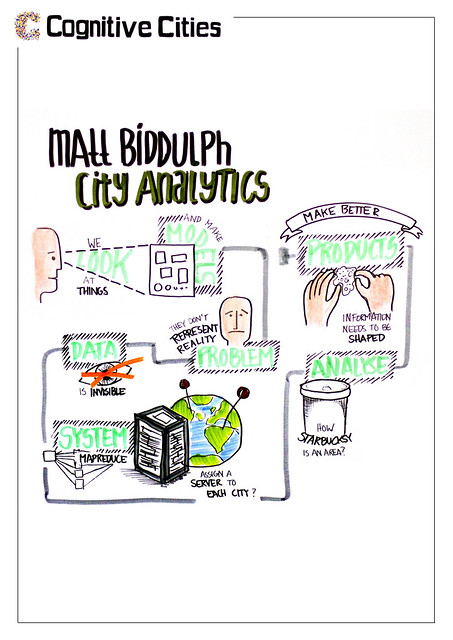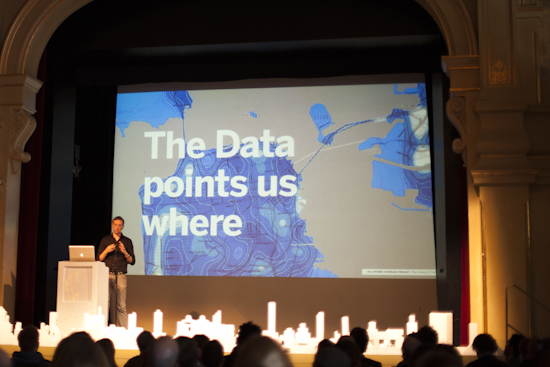|
|
Cognitive Cities conference
- Written by Jørn Knutsen
- Tuesday, 22 March , 2011
In February Einar and I attended the Cognitive Cities conference in Berlin. Einar presented our work on visualising the invisible WiFi networks in the city. The spring-sun-soaked Berlin offered a lovely frame for a weekend dedicated to the ins and outs of the networked city. This post is a brief summary of some of the talks and general themes of the conference.
Public Objects
Adam Greenfield, managing director of Urbanscale, was the first speaker up. Adam’s talk ‘On Public Objects: Connected Things And Civic Responsibilities In The Networked City’ centered around Langdon Winner’s question ‘Do artifacts have politics?’ — the classic battle between techno-determinism and social constructivism. While Winner’s answer is ‘yes’, Bruno Latour’s is a more reluctant ‘maybe’.
Adam presented us with a series of examples of how networked objects are increasingly monitoring our behaviours on our streets and sidewalks, and how we are generating value without any form of consent. Amongst them, Quividi which measures whether or not passersby are paying attention to a billboard, and couples this with facial recognition techniques to record age and gender of the passersby. This gets increasingly hairy, Adam points out, when these types of systems can have their capabilities extended and altered beyond their intended and contracted use through future software upgrades. Thus, pointing to the statement from Lawrence Lessigs that ‘Code is Law’.
In ending Adam pointed towards a need for a new jurisprudence, a body of law, to guide how we think about, what he labels, ‘public objects’. This class of objects should be open as in being available through an API, offering read/write capabilities, being nonrivalrous and nonexcludable. I could not agree more, and as practitioners and researchers we should work towards this by the most effective weapons we have: making and doing.
Here is the recording of Adam’s talk:
Adam Greenfield at Cognitive Cities Conference from Cognitive Cities on Vimeo.
Living Cities
Anil Bawa-Cavia, the former data-cruncher at Last.fm, is currently directing his amazing forces towards real-time data from cities, doing a PhD at the University College London’s Center for Advanced Spatial Analysis. Similar to our work on visualising WiFi networks in the city, Anil is concerned with making the flows and networks of interactions visible and tangible through visualising data.

Anil Bawa-Cavia has drawn a new map of New York based on frequency of Foursquare check-ins
We have been following Anil’s work for some time, and it was lovely hear him talk about his project from 2010 that uses Foursquare data to draw new maps of London, Paris and New York. As Anil points out, through these activity fingerprints we can see how the cities are actually used, and not how it was planned or built.
Anil has also got his hands on data from the London Underground of where people check in and out with their Oyster cards. Using shortest path algorithms he has animated the Londoners’ trails throughout the day.
Oyster Flowprint from Anil Bawa-Cavia on Vimeo.
Read more in Anil’s transcript of his talk.
Similar to Anil’s work, Matt Biddulph Head of Data Strategy for Ovi products at Nokia talked about how they are exploring big datasets that Nokia posses to make new products and services. One of their explorations also involved analysing check-ins from Foursquare and Ovi at Dolores Park in San Francisco. And, indeed, people do check-in less in the park on a rainy day.
So, however beautiful and fascinating as these illustrations and animations are, they don’t necessarily reveal to us anything new, anything we don’t already know just by being and living in the city. Maybe we should rather see them as evidence of the level of detail and richness in the data, and as Matt pointed out, that we now have enough computing power to play around with it. I do look forward to seeing the outcome of deeper explorations and the magic of pairing this with all sorts of other data.

Data Materials
The recurring, underlying theme of the day seemed to be the increasing importance of city data as a design material. As Adam noted, public objects now has the ability to gather, process, transmit, display and take action on data. This is not only true about public objects, but also personal products that you can buy of the shelves today. This is part of what we label ‘hybrid products’ — products that are connected to online services, that are based around digital data (often from sensors) and that rely on digital networks to function. In the journal Computers and Composition we have a forthcoming article, ‘Investigating an Internet of Hybrid Products’, that takes up this relationship between products, people and the Internet. In this article we point at how these ‘hybrid products’ now are highly available in popular culture, in our shoes and cities and in need of attention from design research. We will discuss this more as soon as the article is published.
Sami Niemelä, Creative Director of Helsinki-based Nordkapp, focused his talk on displays and how urban touchpoints should be more humanlike to help people empathise with services and interfaces just a little bit more. I believe, however, when going down this path towards more emotional and lifelike products and services, we need to be careful as to not slip down into the uncanny valley. You can do worse than reading Ben Bashford’s brilliant post about ‘emoticomp’ on this topic.
Lastly, I want to thank the organisers of the conference for creating a such friendly and warm atmosphere. Job well done. See you next year!



